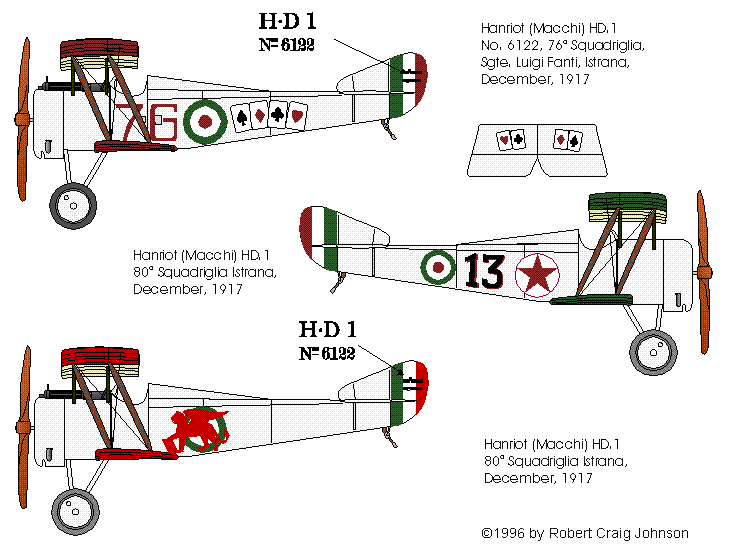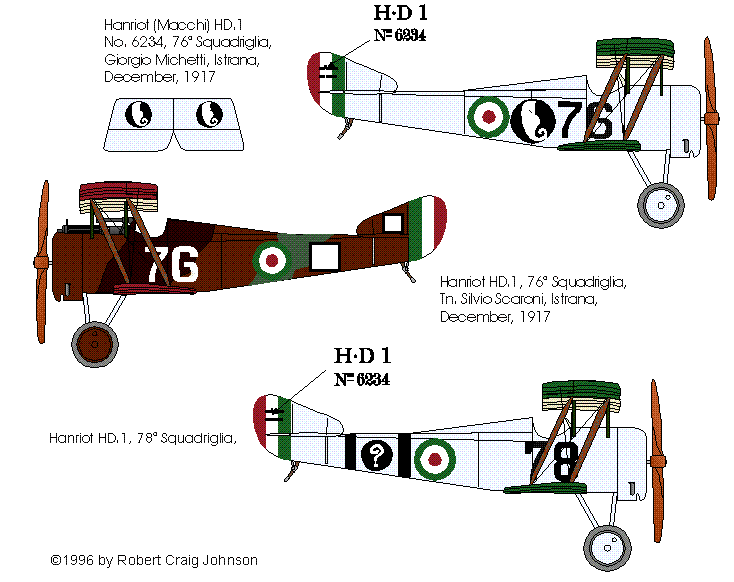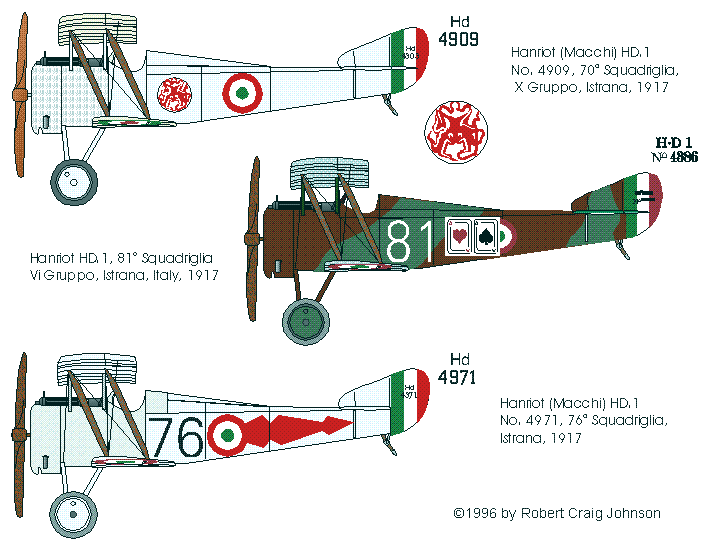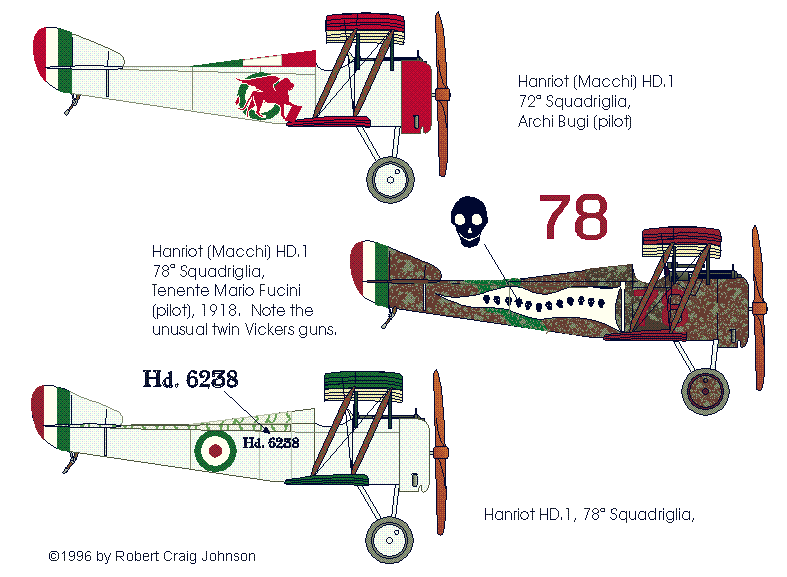
The Hanriot HD.1 fighter was a comparative rarity in aviation history: a highly successful, high-performance aircraft that was never adopted by the country that developed it. The HD.1 came along at an awkward moment for a French fighter. It was just too late to compete with the Nieuports that formed the backbone of French fighter aviation in the first years of the war. By the time it appeared, it was eclipsed by the SPAD 7. The SPAD became the standard fighter of the French air force. The French did, however, allow Hanriot to market its new airplane to France’s allies. Belgium bought a modest number, as did the U.S. Navy. But the major user of the HD was Italy.

The Italians chose the airplane as the successor to the Nieuport 17, their then standard fighter. While some aircraft were imported from the parent firm, Nieuport-Macchi obtained a manufacturing license and became, in fact, the major builder of the type. During the massive Italian offensive of October 1918, 130 out of then 211 fighter squadrons available were mounted on Hanriot’s. Most of the Italian aces flew the Hanriot HD at one time or another, most notably Silvio Scaroni (26 victories). It saw service primarily on the Alpine and Venetian fronts, where it was frequently mistaken for a Sopwith in Austrian reports. But it also operated over Albania and Macedonia.

A grand total of 831 Hanriot HD1s were delivered to the squadriglia da caccia by 1918, out of more than 1700 ordered, and production continued after the Armistice. Despite the arrival of more modern types, including the SPAD XIII, the Hanriot did not pass out of Italian service until 1925.
Prior to February 1918, Hanriot fighters were finished in either of two schemes. The most common scheme was silver dope over all surfaces except, possibly, the undersides of the flying surfaces, which could conceivably have been finished in clear varnish alone. Photographs would probably not show much tonal difference between the two colors. Silver dope was probably more of a light, slightly bluish grey. It was made by mixing aluminum powder into clear varnish. The aluminum protected the fabric from the sun and kept it from deteriorating. Some Italian Hanriot's received the Hanriot factory's version of the standard French camouflage of the period. This was a three- or four-color segmented pattern that one disapproving Belgian aviator compared to a painted toy snake. The colors have been described as dark brown, medium brown, medium green, and blue-grey or buff, brown, medium green, and dark green. This finish was standard on Belgium's French-built machines, so it is possible that the segemnt-camouflaged Italian aircraft were the imported, Hanriot- built airplanes while the silver-doped machines were the Macchi version.

In February, 1918, camouflage was mandated for all flying surfaces and the cowlings, at a minimum. The Squadriglie appear to have responded to this order by enthusiastically daubing the upper surfaces of their machines with paint, producing a mottled effect. In a recent article in Over the Front (11[Summer 1996]:180-85), Alan Durkota shows several examples of two different applications of this technique. A photograph of airframe Hd. 6238 shows a light fuselage, cowling, and lower wing with dark zig-zag camouflage over the top decking of the fuselage aft of the cockpit and, perhaps, over the upper wing (n.b. captions for Hd.6238 and Hd.20949 appear to be transposed). Mr. Durkota interprets this as "overall...light grey-green" with "a dark green mottle. The other scheme is illustrated by two photos, one of ace Mario Fucini's airplane and the other of Hd.20949. Mr. Durkota's caption describes these as a field- applied "mottle finish of light and dark green superimposed over a yellowish base color" and "a factory applied finish of tightly swirling tones of light and dark green applied over a yellowish base color." It seems more likely that both types of finish are in fact attempts to tone-down the two standard factory finishes, silver dope ("greenish-grey") and the French-style "toy-snake" camouflage. A lightish green (lighter than the insignia) could have been daubed over silver surfaces to produce the scheme seen on Hd.6238 and over the segmented camouflage to produce the odd-looking finish seen on Hd.20949 and on Fucini's airplane. This certainly seems simpler and more military than imagining four or five different official schemes, especially if, as I suspect, the aircraft in the photo under Hd.6238 is in fact the standard French segmented finish rather than the additional "two-tone pattern of light and dark green" described in the caption. It is probable that no one really knows, of course, but small familiarity with the military mind suggests that the simpler explanation is more likely.

Italian fighters carried national cockades on the upper wings and usually on each side of the fuselage. Rudders were striped in the usual Allied fashion. However, Italy tolerated considerably more variation in national markings than its principal allies would. Reading from the center (for roundels) or the leading edge (for rudder stripes), the colors could run red-white-green or green-white-red. The relative widths of the bands of color appear to vary in photographs, as do the precise shades of the colors used (though possibly this is the result of different degrees of exposure to the sun). Fuselage roundels could vary in size and could appear much closer to the cockpit than they would on British airplanes. The early-war practice of painting the outer third of the undersurfaces of the wings in the national colors persisted to the end of the war.
Notes for the modeler. The HD.1 has been released as a 1/72-scale injection-molded kit by Pegasus and, possibly, as a resin kit by by Czech Masters. Eduard is planning to release an injected 1/48-scale kit sometime in the new year. A resin 1/48-scale kit was offered by JMGT.
Gregory Alegi. "26 December 1917: The Air Battles of Istrana." Cross & Cockade International (26.1[ 1995]:40-49).
J. M. Bruce. "Hanriot HD.1." Fighters. Warplanes of the First World War. Vol. 5: France. Garden City, NY: Doubleday, 1972. 3-11.
J. M. Bruce. The Hanriot HD 1. London: Profile Publications, n.d.
Alan Durkota. "A League of Modelers: The Hanriot HD.1." Over the Front (11[Summer 1996]:180-85).
Kenneth Munson. Fighters 1914-1919. New York: MacMillan, 1968.
A future issue will illustrate the HD fighters in Belgian, USN, and Swiss service.
© 1996 by Robert Craig Johnson. First published in Eagle Droppings, the Newsletter of the Rocky Mountain Chapter, IPMS/USA.